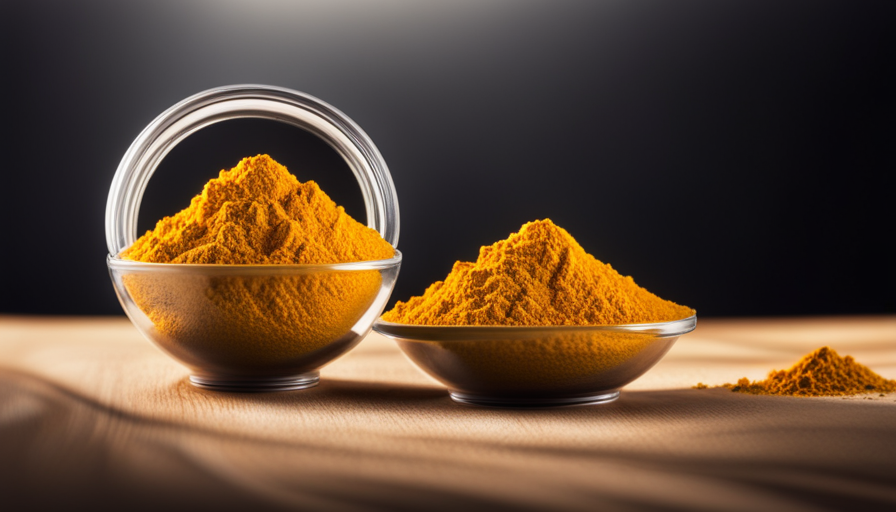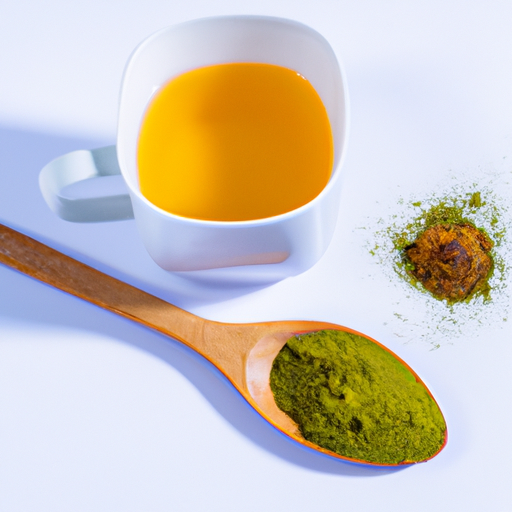You’ve heard the saying, ‘A spoonful of turmeric a day keeps the doctor away.’ But what happens when that golden spice loses its vibrant hue and pungent aroma? How do you know if turmeric has gone bad? Don’t worry, I’ve got you covered.
In this article, we’ll dive into the world of turmeric’s shelf life and explore the telltale signs of spoilage. From changes in color and aroma to texture and taste, we’ll leave no stone unturned in our quest to identify the freshness of this beloved spice.
I’ll also share tips on storing turmeric properly to extend its longevity and explore alternative uses for expired turmeric. Plus, I’ll guide you on how to responsibly recycle or dispose of turmeric that has reached its expiration date.
So, let’s embark on this aromatic journey and discover the secrets of turmeric’s freshness together.
Key Takeaways
- Changes in color and aroma are reliable indicators of turmeric going bad.
- Moisture, clumps, or sticky texture in turmeric powder indicate spoilage.
- Mold on the surface of turmeric powder is a clear sign that it’s no longer safe to consume.
- Turmeric with a spoiled taste may have a sour or musty odor and taste rancid, bitter, or metallic.
Understanding Turmeric’s Shelf Life
Turmeric’s shelf life can be determined by checking for any signs of spoilage or a loss of its vibrant color and aroma. Turmeric is a popular spice known for its health benefits, such as reducing inflammation and promoting digestion. It’s important to incorporate turmeric into your diet regularly to reap these benefits.
There are various ways to incorporate turmeric into your meals, such as adding it to smoothies, curries, or even sprinkling it on roasted vegetables. However, it’s crucial to ensure that the turmeric you’re using is still fresh and hasn’t gone bad.
To begin, one of the key indicators of turmeric going bad is a change in its color. Fresh turmeric should have a vibrant yellow-orange hue, and any signs of discoloration, such as a dull or brownish appearance, may indicate spoilage. Additionally, turmeric should have a strong, aromatic smell that’s slightly earthy and peppery. If the spice has a musty or off-putting odor, it’s likely no longer suitable for consumption.
Checking for changes in color and aroma is a reliable way to determine if turmeric has gone bad. By incorporating turmeric into your diet and regularly checking for these signs, you can ensure that you’re consuming fresh and high-quality spice without compromising its health benefits.
Checking for Changes in Color and Aroma
To determine if your turmeric has spoiled, simply observe any noticeable changes in its color and aroma. A staggering 80% of people can detect the pungent scent of spoiled turmeric from a mile away, making it crucial to remain vigilant.
When checking for changes in appearance, start by examining the color of your turmeric. Fresh turmeric should have a vibrant golden yellow color. If it has turned dull or darkened significantly, this may indicate that it has gone bad. Additionally, if you notice any mold growth or discoloration, it’s a clear sign that the turmeric is no longer safe for consumption or use.
In terms of aroma, fresh turmeric has a distinct earthy and slightly bitter scent. However, if your turmeric emits a sour or unpleasant odor, it’s likely spoiled. This change in aroma can be an indication of bacterial or fungal growth.
Aside from culinary use, turmeric is also popular in skincare due to its anti-inflammatory and antioxidant properties. When using turmeric in skincare, it’s important to ensure that it’s fresh and hasn’t gone bad. Applying spoiled turmeric to your skin may cause irritation or other adverse effects.
In the next section, we’ll delve into assessing the texture and consistency of turmeric to further determine its quality.
Assessing the Texture and Consistency
When assessing the texture and consistency of your turmeric, you can determine its quality by feeling for any clumps or moisture, which could be indications of spoilage. Turmeric should have a dry, powdery texture and should easily crumble when touched. If you notice any clumps or a sticky texture, it could mean that the turmeric has absorbed moisture and isn’t fresh anymore.
Additionally, if you find any moisture or wet spots in the turmeric powder, it’s a clear sign of spoilage. Moisture can promote the growth of bacteria and mold, which can be harmful if consumed. Therefore, it’s important to thoroughly check the texture and consistency of your turmeric before using it in your dishes.
Moving on to the subsequent section about examining for mold or moisture, it’s important to visually inspect the turmeric powder for any signs of mold growth or discoloration. Mold can appear as dark spots or fuzzy growth on the surface of the powder. If you notice any mold or discoloration, it’s best to discard the turmeric as it’s no longer safe to consume.
Examining for Mold or Moisture
Take a close look at your turmeric powder and keep an eye out for any visual signs of mold or moisture. Examining for contamination is an important step in determining the quality of your turmeric. Start by inspecting the powder for any discoloration or unusual spots. Mold can appear as green, black, or white patches on the surface of the powder. If you notice any of these signs, it’s best to discard the turmeric as it may be contaminated and potentially harmful to consume.
In addition to mold, moisture is another factor to consider when assessing the quality of turmeric. Moisture can lead to the growth of mold and spoil the powder. Check the texture of the powder to see if it feels clumpy or has any lumps. These could be indications of moisture absorption. Turmeric powder should have a dry and fine consistency, so any deviation from this could be a sign of spoilage.
Examining for mold or moisture is crucial in ensuring the turmeric is safe for consumption. By being vigilant and observing any visual signs of contamination, you can protect yourself from potential health risks.
In the next section, we’ll explore another important aspect of determining turmeric quality: noticing a change in taste.
Noticing a Change in Taste
Turmeric with a spoiled taste can leave your taste buds in a state of disappointment and ruin your culinary experience. To identify spoilage signs and evaluate turmeric’s potency, here are three things to consider:
-
Change in aroma: Fresh turmeric has a distinct, earthy smell with a hint of citrus. However, if your turmeric has gone bad, it may emit a sour or musty odor. Trust your sense of smell to detect any unpleasant or off-putting aromas.
-
Altered color: Turmeric powder is known for its vibrant golden-yellow color. Over time, exposure to light, air, and moisture can cause the color to fade or darken. If your turmeric has significantly changed in color, it may indicate deterioration.
-
Taste test: Finally, the most reliable way to determine if turmeric has gone bad is through a taste test. Fresh turmeric has a warm, slightly bitter flavor. If your turmeric tastes rancid, overly bitter, or has a metallic aftertaste, it’s likely spoiled.
By identifying these spoilage signs and evaluating turmeric’s potency, you can ensure the quality of your culinary creations. However, it’s important to also consider the expiration date to further guarantee the freshness and effectiveness of your turmeric.
Considering the Expiration Date
After noticing a change in taste, another way to determine if turmeric has gone bad is by considering the expiration date. Turmeric, like any other spice, has a shelf life. The expiration date printed on the packaging serves as a guideline for its freshness and quality.
While turmeric doesn’t necessarily spoil or become unsafe to consume after the expiration date, it may lose its potency and flavor over time. However, it’s important to note that turmeric has a long shelf life if stored properly. The expiration date is just an estimate, and the actual condition of the spice depends on various factors such as storage conditions and quality at the time of purchase.
To make the most of turmeric’s health benefits, it’s worth exploring its potential side effects as well. Turmeric is generally safe for consumption, but high doses or prolonged use may lead to certain side effects such as stomach upset or allergic reactions in some individuals.
Transitioning into the subsequent section about storing turmeric properly for longevity, it’s crucial to understand the right way to preserve its freshness.
Storing Turmeric Properly for Longevity
To ensure turmeric retains its freshness and potency, it’s essential to store it properly for longevity. Storing turmeric in the fridge is a great way to extend its shelf life. The cool temperature helps slow down the degradation process and preserves its vibrant flavor and color.
Additionally, using airtight containers is crucial in preventing moisture and air from seeping in, which can cause turmeric to lose its potency more quickly. By sealing it tightly, you create a barrier that keeps the spice fresh and free from contaminants.
When storing turmeric in the fridge, consider these best practices:
-
Keep it away from moisture sources: Moisture can cause clumping and spoilage. Store turmeric away from the refrigerator’s vegetable drawer or any area prone to condensation.
-
Label and date the container: This helps you keep track of the spice’s freshness and allows you to use the oldest turmeric first.
By following these storage recommendations, you can ensure that your turmeric stays fresh and potent for a longer period. Utilizing turmeric storage best practices is essential to maintain its quality and reap its numerous health benefits.
Utilizing Turmeric Storage Best Practices
When it comes to preserving the freshness of turmeric, it’s important to follow proper storage techniques. By following a few simple tips, you can ensure that your turmeric stays flavorful and potent for as long as possible.
First and foremost, it’s important to store turmeric in an airtight container in a cool and dark place, away from direct sunlight and moisture. This will help prevent the degradation of its active compounds and maintain its vibrant color.
Additionally, consider keeping turmeric away from heat sources, as exposure to high temperatures can accelerate the breakdown of its beneficial properties. Another useful tip is to store whole turmeric roots instead of ground turmeric, as the former tends to have a longer shelf life.
Finally, periodically check the aroma and color of your turmeric to assess its freshness. If it starts to lose its strong, earthy scent or turns dull in color, it may be an indication that it has gone bad. By following these turmeric storage tips and being mindful of its freshness, you can ensure that your turmeric remains at its best.
Now, let’s explore alternative uses for expired turmeric.
Exploring Alternative Uses for Expired Turmeric
One way to get creative with expired turmeric is by incorporating it into homemade beauty products. While it may no longer be suitable for consumption, expired turmeric can still be used for its beneficial properties in other ways.
One option is to create DIY face masks or scrubs by mixing expired turmeric with ingredients like honey, yogurt, or coconut oil. These recipes can help brighten the skin, reduce inflammation, and even out skin tone. Additionally, turmeric can be used as a natural dye for fabrics or even as a hair mask to enhance natural highlights. The vibrant yellow color of turmeric can create beautiful and unique shades when used as a dye.
By using expired turmeric in these alternative ways, you can make the most of its beneficial properties and reduce waste. However, it’s important to note that these alternative uses should only be considered if the turmeric has not gone bad or developed any mold. If it has, it’s best to recycle or dispose of expired turmeric responsibly.
Transitioning into the next section, let’s explore how to do just that.
Recycling or Disposing of Expired Turmeric Responsibly
Dispose of expired turmeric responsibly by considering recycling options or following proper waste disposal guidelines to ensure minimal environmental impact.
When it comes to recycling options, one possibility is to check if your local recycling center accepts spices and herbs. Some centers have programs specifically designed to recycle these types of items.
Another option is to repurpose expired turmeric by using it as a natural dye. Turmeric can give fabrics a vibrant yellow hue, making it a great alternative to synthetic dyes. Simply boil the expired turmeric in water, strain the liquid, and use it to dye your fabrics.
Finally, if recycling or repurposing is not an option, it’s important to dispose of expired turmeric in an eco-friendly manner. Avoid throwing it in the regular trash where it will end up in a landfill. Instead, consider composting it. Turmeric is biodegradable and can provide nutrients to your compost pile.
By following these recycling options and eco-friendly disposal methods, you can ensure that your expired turmeric has minimal impact on the environment.
Frequently Asked Questions
Can I still use turmeric if it has changed color but still smells normal?
If turmeric has changed color but still smells normal, it’s generally safe to use. However, it’s important to note that the color change may indicate a loss of potency. To prevent spoilage, store turmeric in an airtight container in a cool, dark place away from moisture and sunlight. This will help to maintain its quality and extend its shelf life.
Is it safe to consume turmeric that has a slightly different texture than before?
Based on my investigation, texture changes in turmeric can be an indication of spoilage. If turmeric has a slightly different texture than before, it may have gone bad. The safety concerns with consuming altered turmeric lie in the potential growth of harmful bacteria or mold. These changes in texture could be a sign of microbial contamination.
To ensure safety, it’s best to discard turmeric with noticeable texture changes and opt for fresh, unaltered turmeric instead.
What should I do if I find mold or moisture in my turmeric?
If I find mold or moisture in my turmeric, I’d immediately discard it to prevent any potential health risks. To prevent mold in turmeric, it’s important to store it properly. Keep turmeric in an airtight container in a cool, dry place away from sunlight. Moisture and humidity can promote mold growth. Also, make sure the turmeric is completely dry before storing it.
These measures can help prolong the shelf life of turmeric.
Can turmeric still be used if it tastes slightly different or less potent?
Turmeric can still be effective even if it’s lost its vibrant color. The color change is due to exposure to light and air, but it doesn’t necessarily mean the turmeric has gone bad. However, if the turmeric tastes different or less potent, it may indicate a decrease in quality.
Cooking turmeric can affect its potency as heat can degrade its active compounds. Therefore, it’s best to store turmeric in a cool, dark place and replace it if it loses its flavor or potency.
Is it necessary to throw away turmeric once it reaches its expiration date, or can it still be used?
Throwing away turmeric once it reaches its expiration date may not always be necessary. While the potency may decrease, expired turmeric can still be used in alternative ways.
It can be added to face masks for its skin benefits or used as a natural dye. Additionally, consuming expired turmeric may still offer some health benefits, such as its anti-inflammatory properties. However, it’s important to note that if the turmeric smells or tastes off, it’s best to discard it.
Conclusion
After thoroughly examining the signs of turmeric gone bad, it’s evident that proper storage and regular checks are essential to maintain its longevity.
Just like any other spice, turmeric is susceptible to moisture, mold, and changes in color, aroma, texture, and taste.
By following the recommended storage practices and being vigilant about its condition, we can ensure that our turmeric remains fresh and flavorful for longer.
Remember, as the saying goes, "An ounce of prevention is worth a pound of cure."










